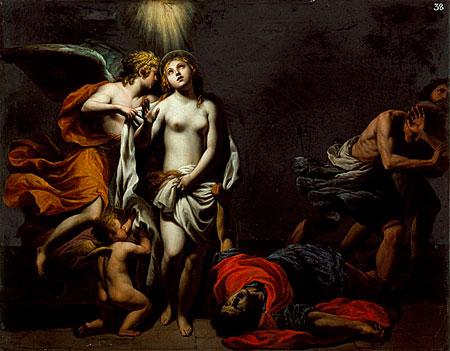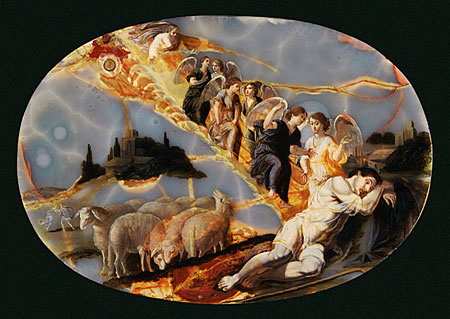Painters are a resourceful lot, constantly experimenting with different materials and the effects they can accomplish. A quiet corner of our new gallery of Northern European paintings is a great example. Curator J. Patrice Marandel has installed a wall of smaller paintings, mostly religious scenes by Italian and Northern European artists. They include paintings on slate, marble, copper, and silvered copper. I talked to conservator Joe Fronek about the science behind the way paint and support interact. Joe explained: “The harder the surface, the less porous it is. Paint really sinks into canvas. It does so to a lesser degree with slate or marble, and even less with copper. You get a wonderful glow. The paint brush doesn’t experience the drag created by a rougher surface.”
You can see this in the juxtaposition of works like Alessandro Turchi’s Saint Agnes Protected by an Angel (c. 1620), painted on marble, and the nearby St. Francis (c. 1600), by Paolo Piazza, where the lighter colors sing atop the marble. Nearby hangs a Simon Vouet painted on canvas. The juxtaposition of works on canvas and works on marble, slate, and copper perfectly illustrates the difference in the way the paint communicates, depending on the underlying surface.
A nearby gallery holds another fine example of painting on marble (in this case, onyx): Jacques Stella’s Jacob’s Ladder (c. 1650). The rich vein in the marble becomes an element of the composition; Stella uses it to represent the ladder, and certain elements of the background landscape. Patrice says the natural vein of the marble is part of the challenge to the painter, providing a jumping-off point (and a non-negotiable element) on which to base the composition. The smooth, light-reflective surface of the marble gives the painting a luminosity it would lack were it painted on canvas or wood. Particularly in the flock of sheep in the foreground, you can really see the marble showing beneath the paint. Joe explained the natural aging process of a painting like this one: “Oil paint is oil mixed with pigment. It binds to the underlying material, and as it dries, it releases solvents. Then it oxidizes and hardens, and a process of deterioration begins. The paint gradually becomes less opaque as it ages. In the case of the Stella painting, the aging process is more apparent, because the underlying material is so colorful.”






